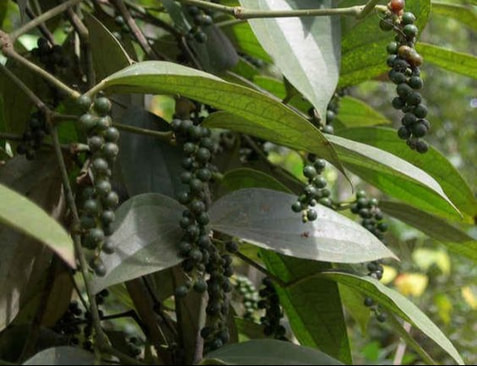|
Black Pepper, often called “the king of spices” is the most commonly used spice in the world for good reason. Not only does it’s potent flavor improve the taste of foods from meats to pastas and every veggie and grain in between it also can be a not so secret ally in your medicine cabinet.
During the Middle Ages, black pepper was one of the most coveted spices in Europe, your status and wealth could be defined by how much black pepper you had in storage. In fact it is one of the spices that pushed Columbus’s trek for a more direct route to India. Sadly, we know how this worked out. Growing and exporting black pepper in Vietnam has recently edged India out of it’s first place slot of growing this plant, but India still boasts having the most prized spice with the highest volatile oil content which makes it the best tasting and the best for healing mojo. Black pepper corns are actually a fruit and they grow like grapes in bunches on a vine that usually reaches 30 feet or so in height. As the fruit ripens it changes color to a dark green. That dark green layer known as a pericarp will darken and get rough as it dries eventually turning black giving us black pepper. There are other “colors” of pepper on the market such as green, white and pink. All peppers have the compound piperine which is the part of the plant that gives us it’s flavor and healing goodness but black has it most concentrated and that is the one with the most healing effects. Ayurvedic and Traditional Chinese Medicine have used it for centuries to help with constipation, tooth decay, sunburn, arthritis, lung disease and heart disease. Scientists have also studied it’s effects on protecting hearing, preventing heart disease by lowering high blood pressure and treating hyperthyroidism. Today scientists have found that it aids in digestion speeding up the transit time that it takes for food to move through the digestive tract and out the body. It also helps people who have dysphasia or difficulty swallowing simply by smelling the oils in black pepper. It also has been shown to inhibit colon cancer growth as both a preventative to avoid a diagnosis of colon cancer and something to take while treating a current case. Piperine not only helps with the above aspects of digestion it also helps you metabolize medications better by increasing the bioavailability of a drugs like antibiotics, beta blockers, calcium channel blockers, cough medicines, arthritis, respiratory medications, TB and even drugs for HIV/AIDS. Other cancers it has been shown to help the body fight are lung cancer and breast cancer. In fact one study published in Cancer Letters, Indian doctors noted an increased lifespan of 65% in animal trials simply by adding black pepper extract to their daily diet. Using black pepper is easy as you can add it to most foods. Look for dark and rough skinned pepper corns, shiny is not your friend here. It’s best to buy whole and grind it fresh as you need it. Your pepper grinder should be metal, glass or plastic not wood as it leeches the oils from the pepper. Meats and fatty foods can take a LOT of pepper so be generous to the point of obnoxious. Add it in marinades, salad dressings and always keep a grinder on the table. I like adding a dash of pepper to teas or even a coffee with warming spices like a chai or cinnamon blend. It’s great with cloves or ginger in tea. PLAY with it. Start small and adjust the more comfortable you get. Black Pepper Rice 1 cup rice 1 TBSP olive oil 1 small dried chile or a dash of chipotle 2 tsp of dried ginger or an inch or so of fresh minced 1-2 tsp cumin 1-2 tsp freshly ground pepper 1 cup onions, chopped- feel free to add in garlic, lots of garlic 1/4 cup sliced almonds or another nut 1. Cook rice according to directions and let it cool for an hour or so. I do it over night all the time. 2. Heat oil in a pan or wok. When oil is hot throw in the dried spices and cook about 30 seconds stirring the whole time. 3. Add in onions and fresh spices if using. Cook for a minute or so and add in rice. Mix together and add in nuts and salt to taste.
1 Comment
|
AuthorWife, Mom, herbalist and friend. Feel free to change the order of the description to fit your needs, I do several times a day. Archives
November 2021
Categories |

 RSS Feed
RSS Feed